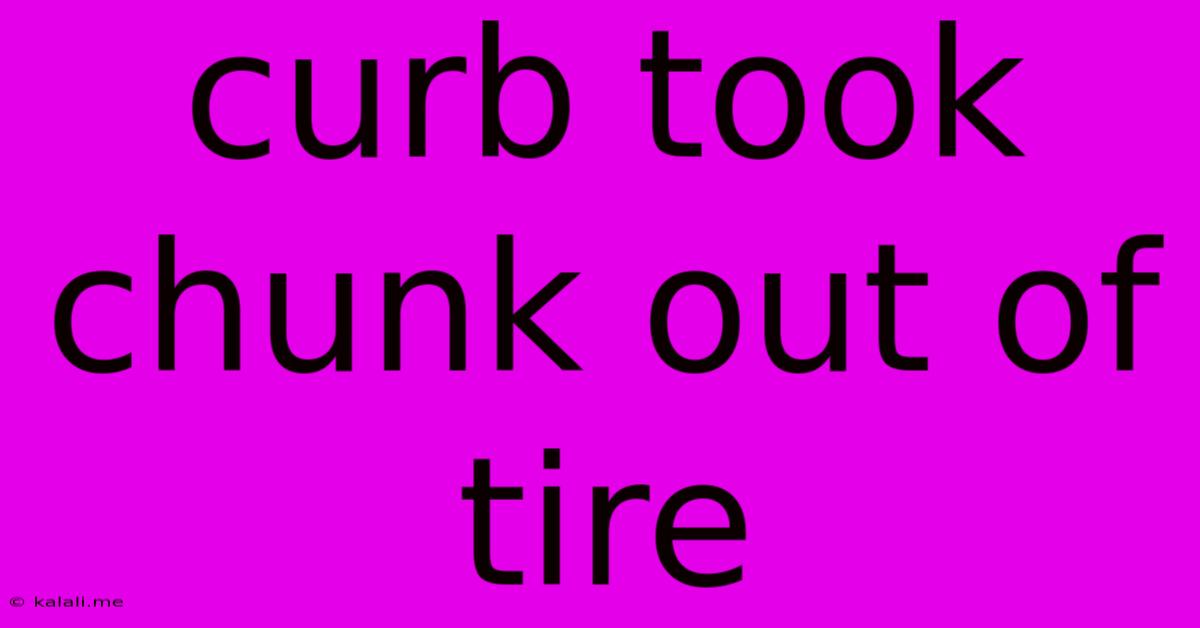Curb Took Chunk Out Of Tire
Kalali
Jun 04, 2025 · 3 min read

Table of Contents
Curb Took a Chunk Out of My Tire: Repair or Replace?
Finding a chunk missing from your tire after a run-in with a curb is frustrating. This article will guide you through assessing the damage, understanding repair options, and deciding whether repair or replacement is the best course of action. Knowing what to do can save you money and ensure your safety on the road.
Assessing the Damage: How Bad Is It?
The first step is to carefully examine the damage. Consider these factors:
- Size and Location: A small nick or scuff on the sidewall is different from a large gouge. Damage to the sidewall is generally more serious than damage to the tread. Sidewall damage weakens the tire's structural integrity, significantly impacting its ability to handle pressure.
- Depth of the Damage: Use a coin or a similar object to gauge how deep the cut is. If you can feel the cords of the tire through the damage, it's likely beyond repair.
- Location Relative to Tread: Damage in the tread area is usually easier to repair than damage on the sidewall. However, large cuts or punctures in the tread that expose the tire's internal structure require professional assessment.
- Presence of embedded debris: Check for any stones, metal fragments, or other debris lodged in the cut. These can cause further damage or compromise a repair.
Repair Options: When Can You Patch a Tire?
Minor cuts and punctures in the tread area might be repairable. However, it's crucial to have a tire professional assess the damage. They have the tools and expertise to determine repairability and perform a safe, effective repair. A tire repair involves plugging the hole from the inside and patching the outer surface.
Never attempt a tire repair yourself unless you have the proper training and tools. Improper repair can lead to tire failure, resulting in a dangerous driving situation.
When Replacement Is Necessary: Understanding the Limits of Repair
There are several situations where repairing a tire is not an option:
- Sidewall Damage: Damage to the sidewall is almost always a reason for replacement. The sidewall is a critical structural component; any damage compromises its integrity.
- Deep Cuts: If the cut penetrates deep into the tire, reaching the tire's cords, replacement is necessary. A compromised structural integrity of the tire cannot be repaired safely.
- Damage Near the Shoulder: Damage near the shoulder of the tire (where the tread meets the sidewall) is often difficult to repair and may compromise the tire’s structural integrity.
- Multiple Damages: If the tire has multiple cuts or punctures, the combined damage is likely to be too extensive for effective repair.
- Signs of Wear: If the tire is already nearing the end of its usable life (indicated by low tread depth), it's generally recommended to replace it rather than repair the damage.
Choosing a New Tire: Factors to Consider
If replacement is necessary, selecting the right tire is crucial. Consider:
- Tire Size: Match the size of your replacement tire to the specifications listed on the sidewall of your damaged tire or in your vehicle's owner's manual.
- Tire Type: Consider your driving needs and habits when choosing between all-season, summer, or winter tires.
- Tire Brand and Quality: Research different tire brands and read reviews to find a tire that meets your budget and performance requirements.
Preventing Future Curb Damage
While accidents happen, you can take steps to minimize the risk of curb damage:
- Pay attention to your surroundings: Drive slowly and cautiously, particularly in areas with potential obstacles like curbs.
- Maintain proper tire pressure: Underinflated tires are more susceptible to damage.
- Practice smooth driving: Avoid abrupt turns and maneuvers that can put stress on your tires.
In conclusion, assessing the extent of curb damage to your tire is critical for determining the best course of action. Always err on the side of caution and consult a tire professional for accurate assessment and repair or replacement. Your safety and the safety of others should always come first.
Latest Posts
Latest Posts
-
How Long Does Meat Sauce Last In The Fridge
Jun 06, 2025
-
Caulk Or Grout Between Tub And Tile
Jun 06, 2025
-
How Does A Bathtub Drain Work
Jun 06, 2025
-
Do Endermites Spawn In The Nether
Jun 06, 2025
-
How To Compute Correlation Of 2 Dimensions 4 Numbers
Jun 06, 2025
Related Post
Thank you for visiting our website which covers about Curb Took Chunk Out Of Tire . We hope the information provided has been useful to you. Feel free to contact us if you have any questions or need further assistance. See you next time and don't miss to bookmark.